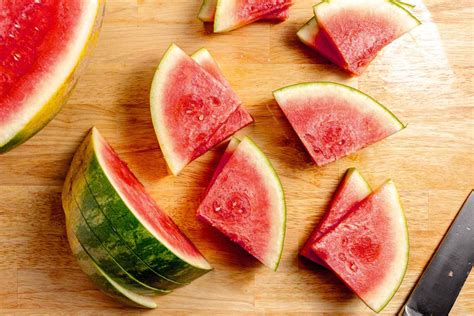
A food editor has revealed a simple and efficient watermelon-cutting method that eliminates mess and maximizes the amount of usable fruit. This involves halving the watermelon, scoring the flesh in a grid pattern, and then easily separating the cubes.
With summer in full swing, watermelons are a staple at picnics, barbecues, and everyday meals. However, the task of cutting this large, juicy fruit can often be cumbersome and messy. Traditional methods typically involve wrestling with a large knife, resulting in uneven slices, wasted fruit, and sticky surfaces. Enter food editor Mackenzie Filson, who recently shared her genius watermelon-cutting hack with Yahoo Life, promising a more efficient and less messy approach.
According to Filson, the key to a perfectly cubed watermelon lies in a few simple steps. First, the watermelon is cut in half. Then, the flat side of each half is placed down on a cutting board for stability. Next, the flesh is scored in a grid pattern, creating evenly sized cubes. Finally, the cubes are easily separated from the rind, making them ready to eat or use in recipes.
Filson emphasizes the benefits of this method, stating that it not only reduces mess but also maximizes the amount of usable fruit. “This method ensures that you get the most out of your watermelon, leaving minimal fruit behind on the rind,” she explains. The uniform cubes are also ideal for salads, skewers, or simply snacking.
This watermelon-cutting hack is particularly appealing to those who find traditional methods challenging or time-consuming. It eliminates the need for specialized tools or complicated techniques, making it accessible to anyone. The method also promotes safety, as the stable base of the watermelon half reduces the risk of slips and cuts.
Step-by-Step Guide to the Watermelon-Cutting Hack
To successfully execute Filson’s watermelon-cutting hack, follow these step-by-step instructions:
-
Choose the Right Watermelon: Select a ripe watermelon that feels heavy for its size and has a consistent shape. Look for a yellow spot (where the watermelon rested on the ground) as an indicator of ripeness.
-
Wash the Watermelon: Thoroughly wash the exterior of the watermelon with soap and water to remove any dirt or bacteria.
-
Cut the Watermelon in Half: Using a large, sharp knife, carefully cut the watermelon in half through the center.
-
Stabilize the Halves: Place one half of the watermelon with the flat, cut side down on a stable cutting board. This will provide a secure base for the next steps.
-
Score the Flesh: Using the same knife, score the watermelon flesh in a grid pattern. Make sure the cuts are deep enough to reach the rind but not cut through it. The size of the cubes can be adjusted according to personal preference.
-
Separate the Cubes: Run the knife along the inside of the rind to loosen the cubes. Then, use your hands or a large spoon to scoop out the pre-cut cubes into a bowl or container.
-
Repeat with the Other Half: Repeat steps 4-6 with the other half of the watermelon.
-
Enjoy or Store: Serve the watermelon cubes immediately or store them in an airtight container in the refrigerator for later use.
Benefits of the Watermelon-Cutting Hack
-
Reduced Mess: This method minimizes the amount of juice and sticky residue, making cleanup easier.
-
Maximized Fruit Usage: By scoring the flesh in a grid pattern, you can extract more of the watermelon, reducing waste.
-
Uniform Cubes: The grid pattern ensures that the watermelon is cut into evenly sized cubes, which are ideal for various recipes and presentations.
-
Increased Safety: The stable base of the watermelon half reduces the risk of slips and cuts.
-
Time-Saving: This method is quicker and more efficient than traditional cutting methods.
Expert Opinions on Watermelon Consumption and Health Benefits
Watermelon is not only a refreshing summer treat but also offers numerous health benefits. According to registered dietitians and nutritionists, watermelon is packed with vitamins, minerals, and antioxidants.
“Watermelon is an excellent source of hydration, as it is made up of about 92% water,” says nutritionist Sarah Johnson. “It also contains vitamins A and C, which are important for immune function and skin health.”
Furthermore, watermelon is a good source of lycopene, a powerful antioxidant that has been linked to a reduced risk of certain cancers and heart disease. “Lycopene is what gives watermelon its red color,” explains Dr. Emily Carter, a registered dietitian. “It’s a potent antioxidant that can help protect your cells from damage.”
Watermelon also contains citrulline, an amino acid that may improve blood flow and lower blood pressure. “Citrulline is converted to arginine in the body, which helps to relax blood vessels,” adds Dr. Carter. “This can have a positive impact on cardiovascular health.”
Creative Ways to Use Watermelon Cubes
Once you’ve mastered the watermelon-cutting hack, the possibilities for using the cubes are endless. Here are a few creative ideas:
-
Watermelon Salad: Combine watermelon cubes with feta cheese, mint, and a drizzle of balsamic glaze for a refreshing and savory salad.
-
Watermelon Skewers: Thread watermelon cubes onto skewers with mozzarella balls, cherry tomatoes, and basil leaves for a colorful and flavorful appetizer.
-
Watermelon Smoothie: Blend watermelon cubes with yogurt, ice, and a touch of honey for a hydrating and delicious smoothie.
-
Watermelon Popsicles: Freeze watermelon cubes with a little lime juice for a healthy and refreshing popsicle treat.
-
Watermelon Gazpacho: Blend watermelon cubes with cucumber, bell pepper, onion, and tomato juice for a chilled and flavorful soup.
The Importance of Food Safety
When preparing watermelon or any other type of produce, it is crucial to prioritize food safety. Proper washing and handling techniques can help prevent the spread of harmful bacteria and reduce the risk of foodborne illness.
The Centers for Disease Control and Prevention (CDC) recommends the following food safety tips:
-
Wash Your Hands: Wash your hands thoroughly with soap and water for at least 20 seconds before and after handling food.
-
Clean Surfaces: Clean and sanitize all surfaces and utensils that come into contact with food.
-
Rinse Produce: Rinse fruits and vegetables under running water before cutting or eating them.
-
Separate Raw and Cooked Foods: Keep raw meats, poultry, and seafood separate from fruits and vegetables to prevent cross-contamination.
-
Refrigerate Promptly: Refrigerate perishable foods within two hours to prevent bacterial growth.
The Growing Popularity of Food Hacks
In recent years, food hacks have become increasingly popular, thanks to social media platforms like TikTok, Instagram, and YouTube. These platforms provide a space for home cooks and professional chefs alike to share their tips and tricks for simplifying meal preparation and enhancing culinary experiences.
“Food hacks are a great way to make cooking more accessible and enjoyable,” says chef Michael Thompson. “They can help people save time and effort in the kitchen, while also encouraging creativity and experimentation.”
The appeal of food hacks lies in their simplicity and practicality. They often involve using everyday ingredients and tools in innovative ways to achieve impressive results. Whether it’s a new way to cut an onion, peel garlic, or cook an egg, food hacks can make a significant difference in the kitchen.
Expert Advice on Choosing the Perfect Watermelon
Selecting the right watermelon is essential for ensuring a sweet and juicy treat. Here are some tips from watermelon experts:
-
Look for a Yellow Spot: The yellow spot, also known as the ground spot, indicates where the watermelon rested on the ground while ripening. A creamy yellow spot suggests that the watermelon is ripe and flavorful.
-
Check the Shape: Choose a watermelon that is symmetrical and has a consistent shape. Avoid watermelons with bumps or flat spots, as these may indicate uneven ripening.
-
Feel the Weight: Pick up the watermelon and feel its weight. A ripe watermelon should feel heavy for its size, indicating that it is full of juice.
-
Thump the Watermelon: Gently thump the watermelon with your knuckles. A ripe watermelon should produce a deep, hollow sound.
-
Examine the Stem: If the watermelon has a stem, it should be dry and brown. A green stem may indicate that the watermelon was picked too early and is not fully ripe.
Watermelon and its Cultural Significance
Watermelon has a rich cultural history and is often associated with summer celebrations and gatherings. In many cultures, watermelon is seen as a symbol of abundance, fertility, and good fortune.
In the United States, watermelon has been a popular summer treat for generations. It is often served at picnics, barbecues, and Fourth of July celebrations. Watermelon-eating contests are also a common tradition at summer festivals and fairs.
In Japan, watermelon is considered a luxury fruit and is often given as a gift. Square watermelons, which are grown in special containers, are particularly prized for their unique shape and aesthetic appeal.
In China, watermelon is associated with good luck and prosperity. It is often eaten during the summer months to cool the body and ward off illness.
Sustainability and Watermelon Farming
As consumers become more conscious of the environmental impact of their food choices, sustainable farming practices are gaining increasing attention. Watermelon farmers are adopting various techniques to reduce their carbon footprint and promote environmental stewardship.
Some common sustainable farming practices include:
-
Water Conservation: Implementing efficient irrigation systems, such as drip irrigation, to minimize water waste.
-
Soil Health Management: Using cover crops, crop rotation, and no-till farming to improve soil health and reduce erosion.
-
Integrated Pest Management: Employing natural pest control methods, such as beneficial insects and organic pesticides, to minimize the use of synthetic chemicals.
-
Energy Efficiency: Utilizing renewable energy sources, such as solar power, to reduce reliance on fossil fuels.
By adopting these sustainable farming practices, watermelon farmers can help protect the environment and ensure the long-term viability of their operations.
The Economic Impact of Watermelon Production
Watermelon production is a significant contributor to the agricultural economy in many regions. According to the United States Department of Agriculture (USDA), the value of watermelon production in the United States was over $600 million in 2020.
The top watermelon-producing states include Florida, Georgia, Texas, and California. These states benefit from the warm climate and fertile soil that are ideal for watermelon cultivation.
Watermelon production provides jobs for farmers, farmworkers, and agricultural businesses. It also supports the local economies of rural communities.
Watermelon in Popular Culture
Watermelon has been featured in numerous movies, television shows, and books. It is often used as a symbol of summer, relaxation, and good times.
In the movie “Dirty Dancing,” watermelon plays a memorable role as Baby carries one to a staff party. The scene is a classic example of how watermelon can evoke feelings of nostalgia and summer fun.
In the book “To Kill a Mockingbird,” watermelon is mentioned as a symbol of Southern hospitality and tradition. The Finch family often shares watermelon with their neighbors and friends.
Watermelon has also been featured in popular songs, such as “Watermelon Sugar” by Harry Styles. The song is a catchy and upbeat ode to the sweet and refreshing taste of watermelon.
The Future of Watermelon Cultivation
As the demand for watermelon continues to grow, researchers and farmers are exploring new ways to improve watermelon cultivation. Some areas of focus include:
-
Developing New Varieties: Breeding watermelons that are more resistant to disease, pests, and drought.
-
Improving Yields: Optimizing irrigation, fertilization, and pest control practices to increase watermelon yields.
-
Extending the Growing Season: Developing techniques to grow watermelons in cooler climates or during off-season months.
-
Enhancing Flavor and Nutrition: Breeding watermelons that have a sweeter taste, a more vibrant color, and higher levels of vitamins and antioxidants.
By investing in research and innovation, the watermelon industry can ensure that this beloved fruit remains a staple of summer for generations to come.
Frequently Asked Questions (FAQ)
-
What is the food editor’s name who revealed the watermelon cutting hack? The food editor is Mackenzie Filson.
-
What are the key steps in Mackenzie Filson’s watermelon-cutting hack? The key steps are: cut the watermelon in half, place the flat side down, score the flesh in a grid pattern, and then separate the cubes.
-
What are some of the benefits of using this watermelon-cutting method? The benefits include reduced mess, maximized fruit usage, uniform cubes, increased safety, and time-saving.
-
What nutrients are found in watermelon, according to dietitians? Watermelon is a good source of vitamins A and C, lycopene, and citrulline.
-
What is a common sustainable farming practice used by watermelon farmers? Common practices include water conservation, soil health management, integrated pest management, and energy efficiency.
Conclusion
Mackenzie Filson’s watermelon-cutting hack offers a practical and efficient solution for enjoying this summer favorite. By following her simple steps, anyone can avoid the mess and waste associated with traditional cutting methods and create perfectly cubed watermelon for salads, snacks, or any other culinary creation. Coupled with its numerous health benefits and cultural significance, watermelon remains a beloved and versatile fruit that continues to bring joy to people around the world. The ease and effectiveness of this hack, combined with the ongoing advancements in watermelon cultivation, ensure that this refreshing treat will remain a staple of summer celebrations for years to come. As the popularity of food hacks continues to rise, this watermelon-cutting technique stands out as a testament to the power of simple innovations in making everyday tasks more enjoyable and efficient. From backyard barbecues to elegant summer soirees, the perfectly cubed watermelon, courtesy of Filson’s hack, is sure to be a crowd-pleaser.









